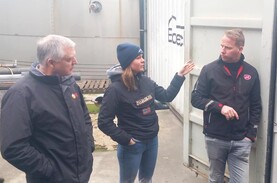Potatoes are a nutritious, healthy and tasty vegetable and continue to be one of the most important sources of food around the world.
There is a long tradition of growing potatoes in Ireland. At one stage, over 800,000 acres of the crop were grown here. That’s nearly twice the size of Co Kildare.
Today, this area has shrunk to around 20,000 acres across 700 farms but potatoes still remain an important part of Irish diets. Most of the potatoes which are grown here are maincrop or ware and are sold fresh for eating. However, we also grow a small amount of seed, chipping and salad potatoes.
While Ireland’s climate is well suited to growing high yields, potatoes remain a challenging crop to grow and they need good crop management.
‘Well sown is half grown’
Like every crop, however, it all starts at the time of planting. As the saying goes, “well sown is half grown”, meaning it is very important to plant the crop in the best conditions possible in order to get it off to a good start. This article will bring you through the key steps when planting potatoes.
Where to grow
Potatoes can be grown in most parts of the country. Like most crops, potatoes will thrive on slightly sloping, south-facing land. The crop needs plenty of moisture so avoid drought-prone fields.
It’s important to keep a good crop rotation when growing potatoes. This means limiting the amount of times maincrop potatoes can be grown in a field to around one in every five years. This avoids the buildup of pests, weeds and diseases.
Seed bed preparation
Potato fields require a lot of work before they can be planted. The first step is to plough the field. Potatoes need plenty of soil so ploughing needs to be deep, around 25cm.
Once ploughed, work begins on forming the drills where the seed potatoes will be planted. It is important that ground conditions are good when carrying out these next few steps, which are normally done between March and April.
Often, the field is grubbed using a grubber to help break up the ploughed soil and it also gives the farmers a good chance to pick up big stones.
Next, a ridging machine heaps the soil into long ridges which are a high and wide. Sometimes, ridging machines also have a rotavator to help further break up the soil and create a fine tilth. However, often this is a separate step using a machine called a bed-tiller.
Once the field is ridged and bed-tilled, the smaller stones need to be removed before planting. Removing stones from the ridges is essential to help minimise the damage to the delicate potatoes during harvest. It also makes it easier for the farmer to grade, clean and sell the crop.
A special machine called a destoner separates small stones and clods of soil from the ridges and places them to the side of the ridge where the potatoes won’t be planted.
Choosing seed
Once the seedbed is prepared, it’s time to plant the crop. While some farmers produce their own seed potatoes, most seed is bought from specialist producers. Seed potatoes grow very well in western and northwestern counties of Ireland due to their very low disease pressure. To ensure seed is of high-quality, it needs to be certified by the Department of Agriculture.
Some of the most common varieties of maincrop potatoes grown in Ireland are Rooster, Kerr’s Pink, Queens, Record and Golden Wonder. Varieties should be chosen because of their yield, quality, maturity, skin finish, disease resistance and, of course, the target market.
Planting
Maincrop planting is normally done between March and April when soil temperatures are around 7oC or higher. The earlier the potatoes are planted, the higher the risk of frost damage. A planter places seed potato around 15cm below the surface in drills which protect them from the elements. Often, fertiliser is planted along with the seed to help the crop in the early stages of growth.
High-yielding potatoes need the right amount of nutrients to grow including nitrogen (N), phosphorus (P) and potassium (K).
Other trace elements are also needed in smaller amounts and are often supplied through granular or liquid fertiliser.
Once the crop is planted, it’s time to apply a herbicide to the surface of the drills to prevent weeds from growing and competing with the emerging potato crop. This is done with a sprayer and is an important step in crop management.
Once the crop has emerged, the farmer has to carefully manage crop nutrition, pests, weeds and diseases right the way through to harvest.






 This is a subscriber-only article
This is a subscriber-only article













SHARING OPTIONS: